Centauri Dreams
Imagining and Planning Interstellar Exploration
End of an Era in Planetary Exploration?
While both Alan Stern and Glen Fountain admitted to having anxious moments over the weekend when New Horizons went silent, it became clear at yesterday’s news conference that those moments were short and quickly subsumed with ongoing duties. Stern is principal investigator for New Horizons, and the man most closely identified with making the mission a reality, while Fountain is project manager for New Horizons at JHU/APL in Maryland. It was Stern who pointed out that the spacecraft has been in safe mode a number of times already.
Nine times, as a matter of fact, since launch, although as of yesterday we are back in the realm of normal operations. So the circumstances were not unfamiliar even if this safe mode came so close to destination that it raised inevitable concern and a flutter of worry on Twitter. Stern said he was in the control center six or seven minutes after getting the call that something was wrong. It also turns out that this was the first safe mode occurrence in which the backup computer was involved. So what exactly happened? Here’s Fountain’s explanation:
On the third of July we were preparing for the main event, with encounter mode starting on the 7th. That means loading those commands that are sequenced to get observations from the 7th of July to encounter and on through July 16th. This is a single command load that was to be put on the primary as well as the backup computer.
We had already loaded to the backup and on the 4th were loading to the primary computer, while at the same time taking data we had not been able to get down to the ground and compressing it, to free up the rest of the recorder for all the other data. So we were doing multiple things on the processor at the same time, and as we were doing the compression, the computer couldn’t handle the load. The processor said it was overloaded. The spacecraft then switched to the backup computer and went into safe mode, exactly as it should have.
Thus a timing conflict in the spacecraft command sequence is the culprit. Stern said that the data loss was minimal, with all science operations for Sunday and Monday lost as well as part of Saturday. Altogether, New Horizons lost 30 observations out of a total of 496 scheduled to be made between July 4 and the end of the close approach (the last of these occurring two days after the flyby). Because the team weighs the value of observations according to how close to the planet they are made, these lost sessions aren’t critical, and Stern figures the mission has experienced zero impact in terms of its highest priority science.
“We wish this hadn’t occurred,” Stern added,” but as PI, I can tell you that this is a speed bump in terms of the total return we expect from this flyby. We’re looking forward now to getting back to data collection. Pluto and Charon are already surprising us with their surface appearance.”
Science observations resume today at 1234 EDT (1634 UTC). Meanwhile, we have images captured by the Long Range Reconnaissance Imager (LORRI) between July 1 and 3, which were released immediately after the news conference.

Image: The left image shows, on the right side of the disk, a large bright area on the hemisphere of Pluto that will be seen in close-up by New Horizons on July 14. The three images together show the full extent of a continuous swath of dark terrain that wraps around much of Pluto’s equatorial region. The western end of the swath (right image) breaks up into a series of striking dark regularly-spaced spots, each hundreds of miles in size, which were first detected in New Horizons images taken in late June. Intriguing details are beginning to emerge in the bright material north of the dark region, in particular a series of bright and dark patches that are conspicuous just below the center of the disk in the right image. In all three black-and-white views, the apparent jagged bottom edge of Pluto is the result of image processing. The inset shows Pluto’s orientation, illustrating its north pole, equator, and central meridian running from pole to pole. Credit: NASA/JHUAPL/SWRI.
The image below adds color to the July 3 LORRI image using data gathered by the Ralph instrument, which performs visible and infrared imaging and spectroscopy.
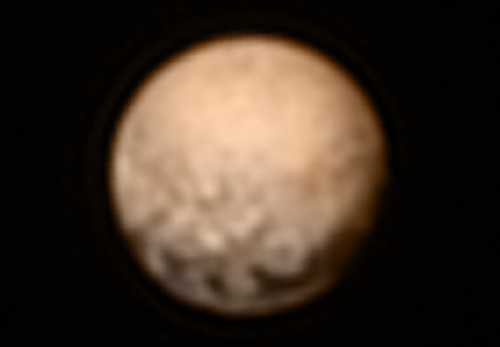
Be sure to read Dennis Overbye’s fine essay in the New York Times on what New Horizons’ flyby of Pluto means in the larger scheme of planetary exploration (you also get the benefit of a video Overbye produced). I owe a lot to Dennis Overbye, whose Lonely Hearts of the Cosmos (HarperCollins, 1991) reignited my long-standing ambition to move from technology writing into astronomy and astrophysics. In the Times essay, he sees New Horizons as the beginning of the end of at least one phase of human exploration.
Beyond the hills are always more hills, and beyond the worlds are more worlds. So New Horizons will go on, if all goes well, to pass by one or more of the cosmic icebergs of the Kuiper belt, where leftovers from the dawn of the solar system have been preserved in a deep freeze extending five billion miles from the sun…
But the inventory of major planets — whether you count Pluto as one of those or not — is about to be done. None of us alive today will see a new planet up close for the first time again. In some sense, this is, as Alan Stern, the leader of the New Horizons mission, says, “the last picture show.”
We are at the edge of a vast sea, as Overbye notes, the one that separates us from the stars. Innumerable explorations await us as we learn more about the Solar System and push outward into the Kuiper Belt. But what a poignant moment as we realize that of the nine ‘classical’ planets (let’s not argue about ‘dwarf’ planets for now), there will never be another moment when one swims into focus for the first time. Let’s cherish the week ahead, and hope that one day humans will experience a similar kind of moment with a new planet in a new solar system.

New Horizons: A ‘Timing Flaw’ Scare Resolved
You get to expect the unexpected when writing about space probes, but somehow what New Horizons did to my weekend completely blind-sided me. Running a routine check of email before (I thought) sliding into the rest of a relaxing work break, I found messages about the glitch on the Pluto-bound spacecraft. Sunday turned into an all-screens-on exercise in checking multiple feeds and waiting for news.
The problem with New Horizons brought to mind a short story I wrote many years ago about an unmanned probe sent to Epsilon Indi on a 90-year journey. The probe is within a month of encounter when all goes silent and Earth controllers can only wait to see what happens.
The point of the story (it was called “Merchant Dying,” published in Charlie Ryan’s Aboriginal Science Fiction in the July/August 1987 issue) was that spacecraft going to another star are going to need autonomous repair capabilities we can only dream of today. New Horizons is a long way out, but we can still work with it through the Deep Space Network, and a check this morning shows DSN’s 70-meter Canberra dish working New Horizons as I write. But space is teaching us all about backup computers and autonomy one step at a time.
The ‘anomaly’ occurred on July 4 and led to a loss of communications with Earth. New Horizons’ autonomous systems were able to switch to the critical backup computer while placing the spacecraft in ‘safe mode’ and re-starting communications. Emily Lakdawalla reports here that the New Horizons Anomaly Review Board met at 1600 EDT yesterday to analyze the situation. The subsequent NASA statement was reassuring, and I’ll quote its latest update in its entirety:
NASA’s New Horizons mission is returning to normal science operations after a July 4 anomaly and remains on track for its July 14 flyby of Pluto.
The investigation into the anomaly that caused New Horizons to enter “safe mode” on July 4 has concluded that no hardware or software fault occurred on the spacecraft. The underlying cause of the incident was a hard-to-detect timing flaw in the spacecraft command sequence that occurred during an operation to prepare for the close flyby. No similar operations are planned for the remainder of the Pluto encounter.
“I’m pleased that our mission team quickly identified the problem and assured the health of the spacecraft,” said Jim Green, NASA’s Director of Planetary Science. “Now – with Pluto in our sights – we’re on the verge of returning to normal operations and going for the gold.”
Preparations are ongoing to resume the originally planned science operations on July 7 and to conduct the entire close flyby sequence as planned. The mission science team and principal investigator have concluded that the science observations lost during the anomaly recovery do not affect any primary objectives of the mission, with a minimal effect on lesser objectives. “In terms of science, it won’t change an A-plus even into an A,” said New Horizons Principal Investigator Alan Stern of the Southwest Research Institute, Boulder.
Adding to the challenge of recovery is the spacecraft’s extreme distance from Earth. New Horizons is almost 3 billion miles away, where radio signals, even traveling at light speed, need 4.5 hours to reach home. Two-way communication between the spacecraft and its operators requires a nine-hour round trip.
Status updates will be issued as new information is available.
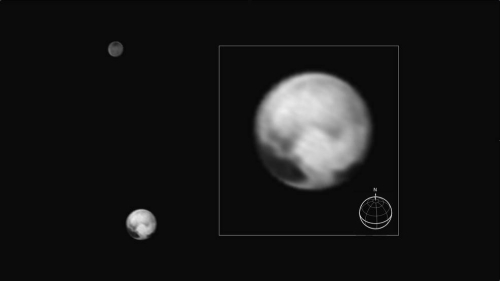
So we’re less than ten days out from Pluto/Charon and a knuckle-whitening moment seems to have passed with little loss of data. With observations re-starting on Tuesday, here’s imagery from July 1, with the inset showing an enlarged Pluto. Features as small as 160 kilometers are visible at this point (credit: NASA/JHUAPL/SWRI). Onward and outward…
Update: More news this afternoon, as per NASA:
NASA will host a media teleconference at 3 p.m. EDT (19:00 UTC) today to discuss the New Horizons spacecraft returning to normal science operations after a July 4 anomaly. The mission remains on track to conduct the entire close flyby sequence as planned, including the July 14 flyby of Pluto…
Audio of the teleconference will be streamed live at http://www.nasa.gov/newsaudio

The Spacecoach Equation
My view is that the spacecoach, the subject of renewed discussion below by Brian McConnell and a design he and Alex Tolley have created, is the most innovative and downright practical idea for getting crews and large payloads to the planets that I’ve yet encountered. It’s low-cost and uses ordinary consumables as propellant, dramatically revising mission planning. Brian and Alex have continued refining the concept, as explained below in Brian’s essay on a modified version of the rocket equation. Have a look and you’ll see that planning long duration missions or missions with larger crews becomes a much more workable proposition because more consumables translate into more propellant. Could the spacecoach be our ticket to building a space-based infrastructure, with unmistakable implications for even deeper space?
by Brian S McConnell
The spacecoach, first introduced here in Spaceward Ho! and A Stagecoach To The Stars and on spacecoach.org, is based on the idea of using consumables waste streams, such as water, CO2 and gasified waste, as propellant in solar powered electric engines. The idea is to turn what is normally dead weight (and a lot of dead weight on a long duration mission such as to Mars) into propellant. This in turn leads to dramatic reductions in mass, and thus mission cost, because a ship that uses waste from consumables as propellant no longer needs an external stage weighing several times as much to push it to its destination. (If you or your colleagues are working on electric propulsion systems and have test data and citations to share see below)
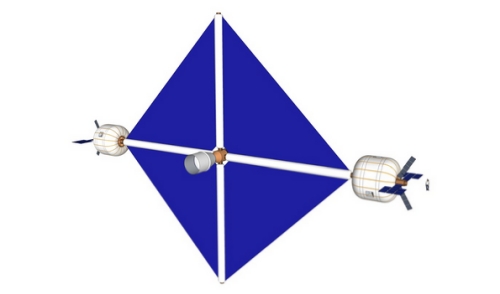
Image: The spacecoach. Credit: Rendering by Rüdiger Klaehn based on a design by Brian McConnell.
To understand the impact this has, we developed a modified version of the rocket equation that leads with the crew consumable requirements for a given mission, and then calculates the level of engine performance required to fly the mission using only consumables waste streams (mostly water and carbon dioxide) as propellant. This, in turn, yields a minimum mission cost, as no surplus propellant is required, so the mission cost is reduced to the cost to deliver the crew and consumables to the starting point (while the ship itself is reusable so its construction and launch cost can be amortized across many missions).
The rocket equation, shown below, predicts the ship’s delta-v (change in velocity), as a function of specific impulse (a measure of engine performance) and the ship’s mass ratio (starting mass divided by ending mass).
![]()
The spacecoach equation, shown below, predicts the minimum exhaust velocity (or specific impulse) required for a cost optimized mission as a function of its delta v and consumables budget.

For programmers, this can also be written in pseudocode as:

Let’s consider a ship that has a 40,000 kg hull mass when empty that is being resupplied for a trip to the Martian moons from EML-2 (Earth Moon Lagrange point 2). With low thrust propulsion this requires a delta-v of roughly 18 km/s roundtrip. The ship has a six person crew, with a 15 kg/person-day budget for water, food and oxygen. The mission is expected to last 600 days, so the consumables budget is 54,000kg.
According to the equation, the engines will need to achieve an exhaust velocity of 21 km/s, which equates to a specific impulse of about 2,100s, assuming 100% of the waste streams are reclaimed (if engines can be made to work with gasified waste, even solids such as trash should be usable as propellant). If we assume that some percentage of the consumables waste streams (e.g. solid waste) cannot be used, say 20%, the engines will need to operate at a specific impulse of 2,900s. This is within the performance envelope of Hall effect thrusters, as well as several other electric propulsion technologies. If the engine performance is not quite good enough, that’s ok, the ship would just be loaded with more water than the crew really needs to compensate for this, or could even support a larger crew. This will increase costs a bit above the minimum possible cost, but also provide safety reserves above what the crew is projected to need.
Next, let’s compare the mass budget for a similar ship using chemical propulsion (e.g. LOX + methane). This mission requires much less delta-v as the ship can exploit the Oberth effect (aka powered flyby) when departing Earth, and on arrival at Mars. To give the chemical ship a further advantage, we’ll assume it uses aerobraking for Mars capture and for Earth return. So the round trip delta-v in that scenario is roughly 8 km/s. The downside is the engine specific impulse is much lower, about 360s for oxygen + methane. Plugging this into the rocket equation results in a propellant mass budget of almost 820,000 kg, over twenty times the mass of the empty hull. This can be optimized by shedding mass, such as waste, spent stages, etc, but not by a great deal without making compromises in terms of consumables, payload, etc (and we’ve already given the chemical ship a big advantage by assuming it can use aerobraking extensively to minimize propulsive delta-v).
Compare this with the spacecoach, where the consumables are the propellant. It would require the delivery of only 54,000 kg of consumables. This is 1/15th what is required for the conventional mission, and should lead to comparable reductions in overall mission costs. Meanwhile the mission itself is much simpler and less risky (all low thrust propulsion, no chemical rockets with catastrophic failure modes, no high G maneuvers, no aerobraking, plus the option to add more crew and/or consumables with little penalty).
The savings come from two sources. Because the consumables are the propellant, there is no need for external propellant. This effect is amplified further because electric engines have much higher exhaust velocities than chemical rockets so even the relatively small consumables mass needed by the crew is sufficient to propel the ship (if electric engines operated at a specific impulse comparable to a chemical rocket, you’d need ten times more water than the crew would consume).
And it gets even better. This is counterintuitive, but it is actually easier to plan for long duration missions with larger crews and high delta v (Ceres, Venus and the Asteroid Belt for example). This is because more consumables = more propellant = higher delta-v given the same engine performance, whereas in a conventional ship you get into a vicious circle of mass incurring more mass. Running the numbers for a 6 person, 1000 day mission to Ceres (delta v : 26.5 km/s roundtrip from EML-2), the consumables budget is 90,000 kg, and the required engine specific impulse is again in the 2000s, which suggests that a ship capable of reaching Mars will be capable of reaching Ceres due to the larger consumables budget.
And speaking of Ceres, it is an enormous water reservoir. While early spacecoaches would be supplied entirely from the Earth, developing the ability to extract water from low gravity sites like Ceres, and possibly the Martian moons, will be a priority as it will reduce the need to launch water from Earth, and thus further reduce operating costs, but even without in situ resource utilization, spacecoaches will be an order of magnitude cheaper to operate, and will be capable of reaching destinations like Ceres that simply cannot be reached by humans using chemical propulsion.
While it takes people a while to see the implications of this (the thinking about how to design a spacecraft is pretty ingrained), the math is pretty straightforward and suggests that order of magnitude cost reductions for interplanetary missions, with greatly expanded range, will be possible with this approach.
If you are working on electric propulsion technology, we are compiling data about the relative performance of different technologies and propellants, especially as it relates to the use of water and waste gases, to provide the community with an easy to search repository of SEP test data and citations. This data will be made available at spacecoach.org as well as on github. If you’d like to submit test data and citations, you can use this form. Contact Brian McConnell at bsmcconnell@gmail.com for more information.

Thoughts on DE-STAR and Laser Sailing
Last week we looked at DE-STAR (Directed Energy Solar Targeting of Asteroids and Exploration), an ambitious program for developing modular phased arrays of kilowatt class lasers. The work of Philip Lubin (UC-Santa Barbara), DE-STAR is envisioned as a way to scale up a space-based system for asteroid mitigation. And in a new NIAC grant, Lubin will study an off-shoot called Directed Energy Propulsion for Interstellar Exploration (DEEP-IN) as a way of driving tiny ‘wafer’ probes on interstellar journeys. Reading about these ideas, Jim Benford responded with the comments below. A plasma physicist and president of Microwave Sciences (Lafayette, CA), Dr. Benford’s work on microwave beaming to sailcraft has included laboratory experiments at JPL with brother Greg that I’ve written about in these pages. Here are his thoughts on DE-STAR’s beaming methods and the issues they invoke.
by James Benford

The calculations presented by the DE-STAR group are basically a revisit of the work of Bob Forward, which was published over 30 years ago. Several other workers have formulated beam-driven sail scaling in the past, so this new group is revisiting that work.
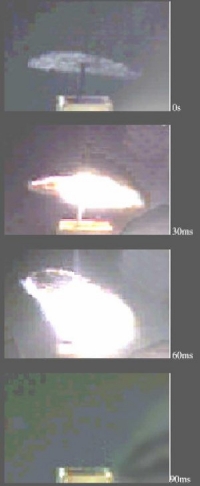
From inspection of their papers, it appears that the DE-STAR group is producing concepts for very low mass, fast sailship probes using a method several others have explored previously: They get very small, light probes by putting all the effort into making them small, at the expense of having an enormous beaming aperture. The very large aperture is not emphasized in their papers, but the smallness of the sail is.
The “realistic” DE-STAR 4 design, for example, has an aperture of 10 km on a side. So the aperture is 330 times larger in linear dimension than the sail, 100,000 times larger in area.
Looking at it from the point of view of cost, such designs are far more expensive than alternatives where the aperture and sail are not so very different in size. (Beamer system cost scales inversely with the sail area.) So the choice of very large aperture drives the capital cost of the system very high; I estimate between 10 and 100 trillion dollars, depending on economies of scale. The operating cost is low because the required power is lower. I would recommend that the DE-STAR group look at cost-optimized methods, which are much more realistic and therefore much more likely to be built.
Image: Testing carbon sails at JPL. Here a carbon disk sail lifts off of a truncated rectangular waveguide under 10 kW microwave power (four frames, 30 ms interval, first at top). Credit: James and Gregory Benford.
Another problem with small sails is that if you do try to launch all of them simultaneously as a constellation, on a beam much larger than a single sail, the sails will not ride on the beam. They will drift off to the side due to perturbations. There are an extensive series of papers on the program I managed in sail acceleration, spin and stability from 1999 to 2005 (two of these are listed below). They describe beam-riding analytically, computationally and experimentally.
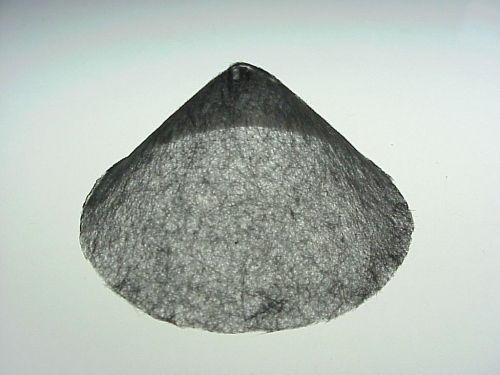
Image: Carbon-carbon sail used in sail stability and spin experiments. SAIL diameter is 5 cm, height 2 cm, mass 0.056 gm. Experiments and simulations show that such conical sails can ride a microwave beam very stably. Credit: James Benford.
So it’s a pretty solid understanding, based on internal reflections on the underside of the sail, as follows:
- The sail must be non-flat, with a conical cone the best shape with the apex pointing away from the beam;
- The diameter of the sail must be of the same order as the transverse dimensions of the beam; and
- Spin helps stabilize beam-riding craft.
This cannot be avoided or all is lost — the sail tumbles. For more, see:
“Stability and Control of Microwave Propelled Sails in 1-D”, Chaouki T. Abdalla, Edl Schamiloglu, James Benford and Gregory Benford, Proc. Space Technology and Applications International Forum (STAIF-2001), Space Exploration Technology Conf, AIP Conf. Proc. 552, ISBN 1-56396-980-7STAIF, pg. 552, (2001).
“Experimental Tests Of Beam-Riding Sail Dynamics”, Gregory Benford, Olga Goronostavea and James Benford, Beamed Energy Propulsion, AIP Conf. Proc. 664, pg. 325, A. Pakhomov, ed., 2003.

Methane Detection as New Horizons Closes

As I write, we’re thirteen and a half days out from the Pluto/Charon encounter. New Horizons will make its closest approach to Pluto at 0749 EDT (1149 UTC) on July 14. All of which has had me reading Pluto-related science fiction that I missed along the way, including most recently Wilson Tucker’s “To the Tombaugh Station.” The story, which ran in the July, 1960 issue of Fantasy and Science Fiction, is a murder investigation that includes a journey to the station of the title, which had been established to investigate a ‘Planet X’ still further out in the system. Isaac Asimov has an essay on Pluto in this issue as well.
Image: The cover of the July, 1960 Fantasy and Science Fiction shows a generic moon landing scene by artist Mel Hunter. But if you look at it with our post-1978 (discovery of Charon) eyes, it could be seen as an imaginative take on a Pluto landing, with the Earth on the horizon being replaced by Charon. Given the prominence of “To the Tombaugh Station” on the cover, I found myself doing a double-take.
As to the real Pluto, we now learn that the infrared spectrometer on New Horizons has detected frozen methane on the surface, a compound first observed on the dwarf planet as early as 1976. What New Horizons will bring to the table is the chance to study differences in methane ice from one part of the surface to another. According to this NASA news release, Dale Cruikshank (NASA Ames, and a member of the New Horizons team) led the team of ground-based astronomers that made the original methane detection.
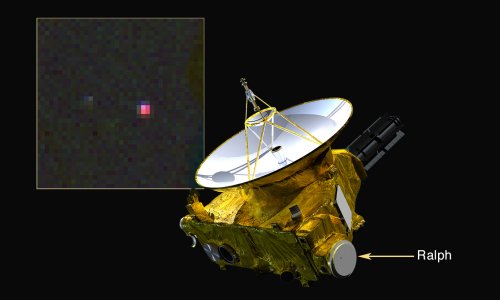
Image: The location of the New Horizons Ralph instrument, which detected methane on Pluto, is shown. The inset is a false color image of Pluto and Charon in infrared light; pink indicates methane on Pluto’s surface. Credit: NASA/Johns Hopkins Applied Physics Laboratory/Southwest Research Institute.
I hope you’re taking advantage of the fact that the raw images from New Horizons are being made available on the JHU/APL website. There you can see images from the spacecraft’s Long Range Reconnaissance Imager (LORRI) displayed without special processing. They’re posted within about 48 hours after coming in to the New Horizons Science Operations Center.
And below is the latest time-lapse movie, this one showing changes in the apparent size of Pluto and Charon as the spacecraft moves from 56 million kilometers to 22 million kilometers. The images involved in this time-lapse approach movie were taken between May 28 and June 25. Pluto continues to show a surface marked by a bright northern hemisphere, with darker material in a discontinuous band along the equator. It’s exciting to see differences emerging on Charon as well, along with the previously noted dark polar region.
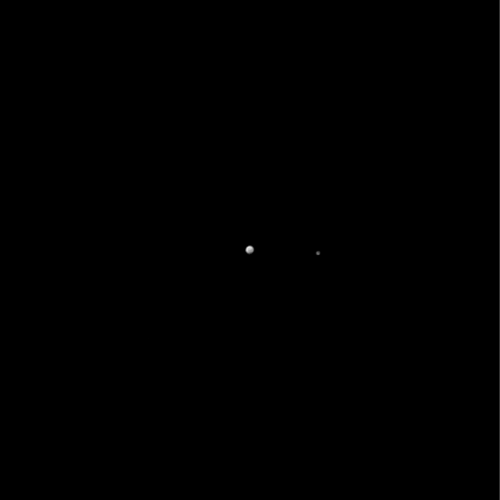
The short video below is an annotated version of the above in which Pluto’s prime meridian (the region of the planet that faces Charon) is shown in yellow and the equator is shown in pink.
New Horizons’ Alice ultraviolet imaging spectrograph performed a test observation of the Sun on June 16 (this from a distance of 5 billion kilometers) to use in the interpretation of atmospheric observations to be taken on July 14. On that day, not long after the Pluto flyby, the spacecraft will study sunlight as it passes through Pluto’s atmosphere. New Horizons scientist Randy Gladstone (SwRI) puts it well: “It will be as if Pluto were illuminated from behind by a trillion-watt light bulb.” That backlight will tell us much about the atmosphere’s composition.
A thruster burn beginning at 1101 EDT (1501 UTC) on June 29, stopping 23 seconds later, was used to make the smallest of the nine course corrections since the spacecraft’s launch in 2006. New Horizons changed velocity by 27 centimeters per second, making a slight adjustment to its arrival time and position at close approach and flyby. The difference upon arrival: The craft would have reached close approach 20 seconds late without the burn, and 184 kilometers off-target.
“This maneuver was perfectly performed by the spacecraft and its operations team,” added mission principal investigator Alan Stern, of Southwest Research Institute, Boulder, Colorado. “Now we’re set to fly right down the middle of the optimal approach corridor.”

A Disruptive Pathway for Planet Formation
Planet formation can be tricky business. Consider that our current models for core accretion show dust grains embedded in a protoplanetary disk around a young star. Mixing with rotating gas, the dust undergoes inevitable collisions, gradually bulking up to pebble size, then larger. As the scale increases, we move through to planetesimals, bodies of at least one kilometer in size, which are large enough to attract each other gravitationally. Some planetesimals break apart through subsequent collisions, but a few grow into protoplanets, then planets themselves.
It’s a reasonable theory that fits what we see around young stars as solar systems take hold. But what Alan Boss (Carnegie Institution for Science) has been working on is a question raised by the process: How do the dust grains and objects smaller than planetesimals keep from being drawn into the protostar before they can become large enough to attract the materials they need to grow? The pressure gradient of the gas in the disk should make smaller objects — particularly those between 1 and 10 meters in radius — spiral inward to inevitable destruction.
By modeling the interactions between protoplanetary disks and their stars, however, Boss has come up with a proposed solution. Stars like the Sun can undergo explosive bursts of a century or so in duration, accompanied by an increase in the luminosity of the star. An explosive phase like this, which Boss’s paper argues can be linked to a period of gravitational instability in the disk, can scatter objects in the 1 to 10-meter range outward from the infant star.
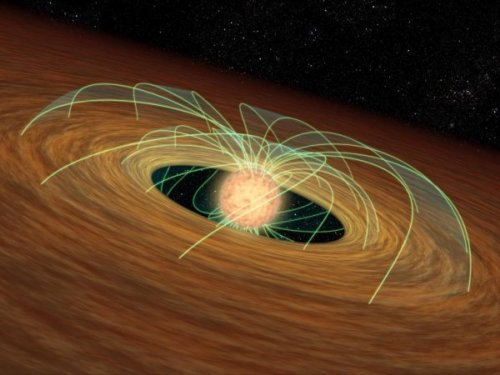
Image: An artist’s concept showing a young stellar object and the whirling accretion disk surrounding it. Credit: NASA/JPL-Caltech.
The paper refers to the disruptions of the disk under scrutiny as ‘marginally gravitationally unstable phases of evolution’ (MGU), but they’re more widely known as ‘FU Orionis events.’ The star FU Orionis is a pre-main sequence star showing just this range of fluctuation in magnitude. It has given its name to the entire class, with other examples being V1057 Cyg and V1647 Orionis. We’re apparently seeing mass from an accretion disk falling into the young star, creating a high-luminosity phase that can persist for lengthy periods.
It has been suggested that eruptions like these can occur from 10 to 20 times as a young star matures. The event is, in any case, striking when it occurs. When V1057 Cyg was first observed undergoing this behavior in 1970, it increased in brightness by 5.5 magnitudes (going from 17th magnitude to 12th) over a multi-year interval. But we have a lot to learn. No FU Orionis star has yet been seen shutting down from its high-luminosity phase. Mike Simonsen provides an excellent background discussion of FU Orionis stars in The Furor over FUORs.
Boss modeled protoplanetary disks undergoing FU Orionis events for disks at 1 to 10 AU containing a wide variety of solid particle sizes subject to gas drag and gravitational forces. Backing up this model of gravitational interaction, recent work has shown that young stars can form spiral arms in their disks like those thought to be involved in the disruptive events Boss has studied. The gravitational forces produced by these spiral arms may be the key to scattering boulder-sized bodies so that they can survive gas drag and grow into planetesimals.
Larger bodies, then, have a chance to survive. Boss’ models showed that over time scales of ~6 X 103 years or longer, about half the gaseous disk mass was accreted onto the protostar, but during this same period, few objects between 1 and 10 meters were lost through inward migration. A much greater fraction of particles between 1 and 10 centimeters were lost to the protostar during the same period, but even here, a significant fraction survive.
“This work,” Boss adds, “shows that boulder-sized particles could, indeed, be scattered around the disk by the formation of spiral arms and then avoid getting dragged into the protostar at the center of the developing system. Once these bodies are in the disk’s outer regions, they are safe and able to grow into planetesimals. While not every developing protostar may experience this kind of short-term gravitational disruption phase, it is looking increasingly likely that they may be much more important for the early phases of terrestrial planet formation than we thought.”
The paper is Boss, “Orbital Survival of Meter-size and Larger Bodies During Gravitationally Unstable Phases of Protoplanetary Disk Evolution,” Astrophysical Journal Vol. 807 (July 1, 2015), No. 1, 10 (abstract).


